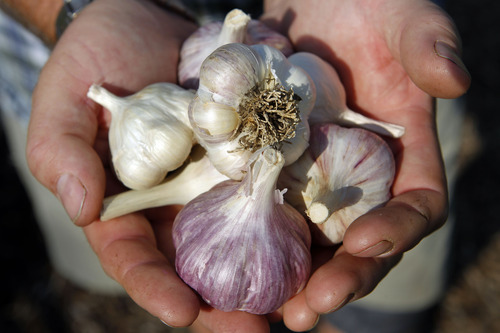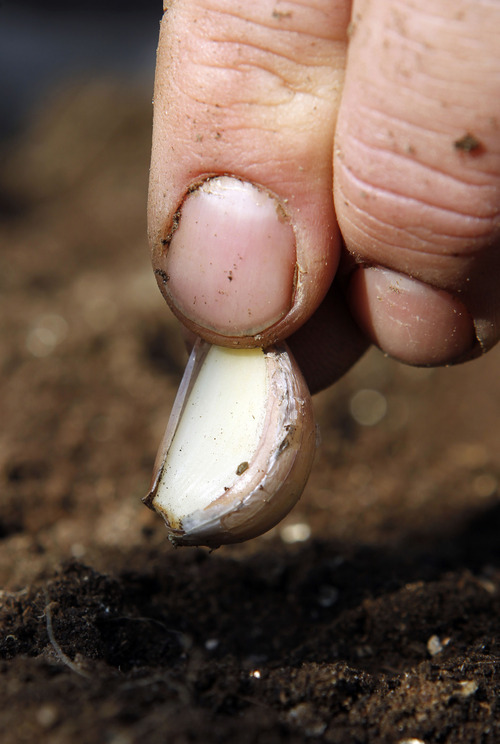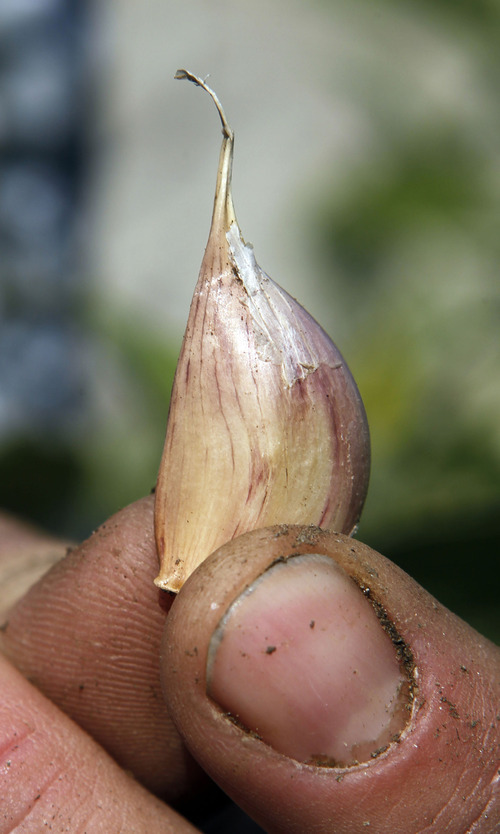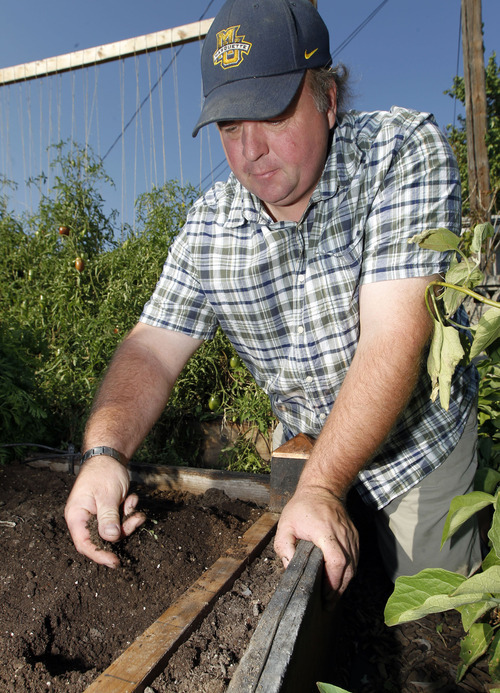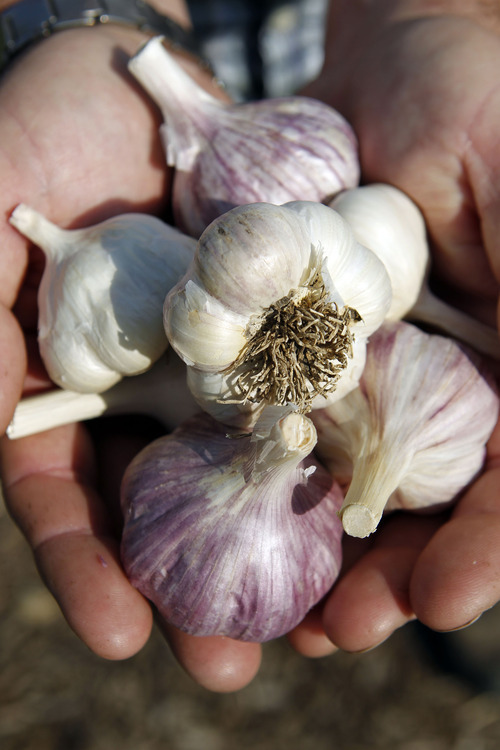This is an archived article that was published on sltrib.com in 2012, and information in the article may be outdated. It is provided only for personal research purposes and may not be reprinted.
Garlic is as old as time itself, cultivated by nomadic tribes in Central Asia 10,000 years ago and buried in the tombs of pharaohs from Egypt's golden age. In contemporary times, many of us will take pride in continuing the garlic legacy handed down by our ancient ancestors, but our relationship with garlic wasn't always so easy. Until the mid-twentieth century, garlic was snubbed as a smelly, ethnic vegetable used only by those who couldn't afford better.
In 1979, when the first celebration of garlic took place in Gilroy, Calif., the only varieties available were the bright-white varieties we commonly associate with grocery stores. Seeking greater diversity in the crop, the United States Department of Agriculture repeatedly asked Russia for access to the many varieties of garlic growing wild in the Caucasus Region, but permission came only after the country became politically unstable in 1989. Bulbs were collected in small villages and named for the locale where they were found. Grown first for the USDA, garlic varieties began to be traded among American farmers, and the interest in heirloom varieties of garlic was born.
Though it may be tempting to plant garlic purchased at the grocery store, commercially grown bulbs are often sprayed with anti-sprouting agents, making them a poor choice for garlic lovers who want to grow their own. Excellent sources of garlic seed stock are farmers markets and local farms either shortly after harvest (generally mid-late July to mid-August) or before next year's crop has been planted (early October). Garlic grown nearby will be better adapted to the local climate than garlic purchased through the mail, and local growers tend to be very knowledgeable about their products and passionate about sharing what they know.
—
Preparing the soil • Once you've found the garlic varieties you'd like to plant (see sidebar), you'll need to select a sunny spot and prepare your soil. Garlic has fairly high nutrient requirements, so before planting, you'll want to incorporate lots of organic matter into your garden beds. Soil that is well-tilled, nutrient-rich, loose, light and crumbly will encourage your garlic to form healthy, well-shaped bulbs.
Garlic should be planted at least four weeks before the ground freezes — in late September through late October in most parts of Utah, says "Farmer Pete" Rasmussen, farm manager and self-proclaimed garlic maniac at Sandhill Farms in Eden. This gives the garlic enough time to establish roots, but not enough to send up green shoots before the ground freezes.
Just before planting, individual cloves should be separated from the bulb, left in their protective wrappers, and planted (pointy side up) at least 2 inches deep and 6–8 inches apart minimum on all sides. After planting, you may choose to mulch your cloves, but be careful not to bury them too deeply: Buried sprouts may have some trouble finding their way in the spring, and overly soggy mulch may contribute to rot, one of very few problems to which garlic is susceptible.
—
Water and fertilize • When the first garlic shoots begin to emerge in early spring, you'll want to remove any excess mulch and begin to water and fertilize the plants regularly. Watering deeply once a week and fertilizing with a high-nitrogen fertilizer for at least the first 3–4 weeks of early growth will give the little garlic plants the additional boost they need to grow large, vigorous bulbs.
During this period of active growth, you also need to diligently weed your planting beds. Because of its shallow root structure, garlic competes poorly with weeds for water and nutrients. "You either grow garlic or you grow weeds, but you don't grow both," Rasmussen said, quoting one of his farming mentors.
In an average year, the lower leaves of your garlic plants will start to die back around the middle of July. About two weeks before harvest, you will want to stop watering your garlic completely, allowing the bulbs some time to "cure" or day in the ground before they are harvested. When about half of the leaves have turned brown, the soil around the bulbs can be gently loosened and the bulbs lifted from the earth with a bulb lifter or garden fork.
—
Curing the bulbs • After gently brushing off any excess dirt, you can move the bulbs — leaves, stalks, roots and all — into a cool, dry area that has good airflow and is out of direct sunlight (like a well-ventilated shed or garage). Hanging the plants from the rafters, bulb side down, for at least two weeks helps them cure properly, which prepares the bulbs for long-term storage and allows the flavor of the garlic to mature. Bulbs are fully cured when their outer wrappers are opaque, all the leaves are brown and no moisture remains in the stalk.
Depending on the variety (and as long as it is stored at temperatures between 50 and 65ºF with low humidity — not in the refrigerator!), most well-cured garlic will keep for at least three months, and some will keep for up to a year. The biggest enemies to storing garlic long term are moisture (which leads to mold) and excess cold (which leads to sprouting), but if your bulbs are treated well, your home-grown supply of fresh, flavorful garlic should be nearly endless — especially if you retain the largest, juiciest bulbs from your summer harvest and use them as seed stock for planting in the fall.
Garlic is self-sustaining, and there's something magical about its cycle of growth. Under cover of snow, single cloves split and multiply, evolving into the large, beautiful bulbs that we harvest, bulbs that have grown quietly underground for three seasons. These are plants that are patient, that clearly echo their wild ancestral roots and that connect us to our collective history: past, present and future.
This season, grow your own garlic and experience why this remarkable plant has been cultivated around the world for millennia.
features@sltrib.com Although fresh, store-bought garlic is far superior to the powdered variety, the nuances in flavor, heat and character of homegrown, handpicked garlic nurtured to maturity in your own garden will be worth the wait. Before you get started, there are a few things you should know.
All true garlics, members of the onion family, are classified as either "softneck" (allium sativum sativum) or "hardneck" (allium sativum ophioscorodon) varieties; within these broad categories, garlic is subdivided into eight distinct groups: Artichoke, Asiatic, Creole, Porcelain, Purple Stripe (including glazed and marbled purple stripe), Rocambole, Silverskin and Turban.
Hardnecks are also known as "bolting" varieties of garlic: They send up a false (seedless) flower stalk called a "scape" in the spring. Some hardneck varieties grow scapes that form multiple loops in the stalk as they grow (giving rise to nicknames like "serpent garlic"), while others create a less-dramatic showing, simply drooping or bending towards the ground in graceful curves. Most gardeners pull or clip garlic scapes to redirect the plant's energy into forming a larger bulb, but Tamra Feenstra, who has been growing garlic in Cottonwood Heights since 2000, found that removing the scapes didn't impact the size of the bulbs, but it did decrease their shelf life.
If you do choose to remove the scapes before they mature, don't toss them. Scapes are edible; tender and delicious when harvested young, they make a flavorful pesto and can impart a delicate garlic flavor to salads, soups and stir-fries. If the scape is allowed to go to flower, tiny seed garlic called "bulbils" will form inside the flower head. Bulbils are edible, but they can also be planted, producing full-sized bulbs in two or three years.
Generally speaking, softneck garlics perform better in warmer climates, although all garlic is highly adaptable over time. Hardneck varieties are more closely tied to their wild ancestors: In addition to thriving in frigid winter climates, they still make an effort to self-propagate, something softnecks have given up on after years of domestication. Each group offers different characteristics, and some will be better suited to your tastes than others.
Softnecks produce layers of cloves that get progressively smaller towards the center of the bulb, can easily be braided and stored through the winter, and have a milder, less complex flavor. Hardnecks usually produce a smaller number of larger cloves, store for a shorter period of time and have a stronger, hotter flavor. If this is your first venture into garlic growing, you might want to select some of each.
Softnecks
French White • Cottonwood Heights gardener's Tamra Feenstra's favorite softneck variety, French White, a member of the Silverskin group, is popular for its large bulbs and lengthy storage life. Highly flavorful, it's also great for braiding.
Red Toch/Tochliavri • A German softneck and member of the Artichoke group, this variety offers a taste that's neither too hot nor too mild but with a spicy bite. Red Toch typically has 12–18 cloves per bulb.
Inchelium Red • This native American strain (also a member of the Artichoke group) comes from the Colville Indian Reservation in Inchelium, Wash. Its large, layered bulbs can have as many as 20 cloves, and it keeps remarkably well. Mild in flavor, it's perfect roasted or added to mashed potatoes.
Hardnecks
Brown Tempest (Mango Sunrise) • In the Purple Stripe group, this good producer is Feenstra's favorite hardneck, with 5–9 plump cloves in each bulb. The wrapper can be purple to brown, with flecks of gold. Sandhill Farms calls it "strikingly beautiful" and "creamy and rich" when baked.
German Red • A member of the Rocambole group, these varieties are the most sensitive to overwatering but grow exceptionally well in the cold. Known for its fawn-colored wrapper, German Red generally has 8 to 9 large, satiny white and purple cloves and is particularly easy to peel. Harvested mid-season, it can be stored until the following June if kept cool and dry. Like other Rocamboles, German Red is full-bodied and spicy, but Bill Masslich at First Frost Farms says roasting it brings out its rich, sweet flavor.
Music/Musick/Corona Music • Randy Hed, of Blue Spring Farm in Bothwell, favors the "rich, sweet, pungent flavor" of Music (a Porcelain). The wrapper has a hint of pink or purple, and the 4 to 7 huge cloves could be mistaken for medium-sized elephant garlic (which is actually more closely related to a leek). One of the first hardnecks to bolt and mature, Music is not as spicy as German Red, but it's one of the best for baking and roasting.
Siberian • Siberian (a member of the Purple Stripe group) is a favorite of Masslich and of Sandhill Farms, as it thrives in cold weather. With wrappers ranging from light pink to mahogany and with 5 to 9 giant purple-streaked cloves, Siberian is a feast for the eyes. Its very high allicin content — possibly the highest of any garlic — gives it great medicinal value, and its earthy, creamy texture makes it a fine choice for garlic spreads. —
Garden-variety garlic
Although fresh, store-bought garlic is far superior to the powdered variety, the nuances in flavor, heat and character of homegrown, handpicked garlic nurtured to maturity in your own garden will be worth the wait. Before you get started, there are a few things you should know.
All true garlics, members of the onion family, are classified as either "softneck" (allium sativum sativum) or "hardneck" (allium sativum ophioscorodon) varieties; within these broad categories, garlic is subdivided into eight distinct groups: Artichoke, Asiatic, Creole, Porcelain, Purple Stripe (including glazed and marbled purple stripe), Rocambole, Silverskin and Turban.
Hardnecks are also known as "bolting" varieties of garlic: They send up a false (seedless) flower stalk called a "scape" in the spring. Some hardneck varieties grow scapes that form multiple loops in the stalk as they grow (giving rise to nicknames like "serpent garlic"), while others create a less-dramatic showing, simply drooping or bending towards the ground in graceful curves. Most gardeners pull or clip garlic scapes to redirect the plant's energy into forming a larger bulb, but Tamra Feenstra, who has been growing garlic in Cottonwood Heights since 2000, found that removing the scapes didn't impact the size of the bulbs, but it did decrease their shelf life.
If you do choose to remove the scapes before they mature, don't toss them. Scapes are edible; tender and delicious when harvested young, they make a flavorful pesto and can impart a delicate garlic flavor to salads, soups and stir-fries. If the scape is allowed to go to flower, tiny seed garlic called "bulbils" will form inside the flower head. Bulbils are edible, but they can also be planted, producing full-sized bulbs in two or three years.
Generally speaking, softneck garlics perform better in warmer climates, although all garlic is highly adaptable over time. Hardneck varieties are more closely tied to their wild ancestors: In addition to thriving in frigid winter climates, they still make an effort to self-propagate, something softnecks have given up on after years of domestication. Each group offers different characteristics, and some will be better suited to your tastes than others.
Softnecks produce layers of cloves that get progressively smaller towards the center of the bulb, can easily be braided and stored through the winter, and have a milder, less complex flavor. Hardnecks usually produce a smaller number of larger cloves, store for a shorter period of time and have a stronger, hotter flavor. If this is your first venture into garlic growing, you might want to select some of each.
Softnecks
French White • Cottonwood Heights gardener's Tamra Feenstra's favorite softneck variety, French White, a member of the Silverskin group, is popular for its large bulbs and lengthy storage life. Highly flavorful, it's also great for braiding.
Red Toch/Tochliavri • A German softneck and member of the Artichoke group, this variety offers a taste that's neither too hot nor too mild but with a spicy bite. Red Toch typically has 12–18 cloves per bulb.
Inchelium Red • This native American strain (also a member of the Artichoke group) comes from the Colville Indian Reservation in Inchelium, Wash. Its large, layered bulbs can have as many as 20 cloves, and it keeps remarkably well. Mild in flavor, it's perfect roasted or added to mashed potatoes.
Hardnecks
Brown Tempest (Mango Sunrise) • In the Purple Stripe group, this good producer is Feenstra's favorite hardneck, with 5–9 plump cloves in each bulb. The wrapper can be purple to brown, with flecks of gold. Sandhill Farms calls it "strikingly beautiful" and "creamy and rich" when baked.
German Red • A member of the Rocambole group, these varieties are the most sensitive to overwatering but grow exceptionally well in the cold. Known for its fawn-colored wrapper, German Red generally has 8 to 9 large, satiny white and purple cloves and is particularly easy to peel. Harvested mid-season, it can be stored until the following June if kept cool and dry. Like other Rocamboles, German Red is full-bodied and spicy, but Bill Masslich at First Frost Farms says roasting it brings out its rich, sweet flavor.
Music/Musick/Corona Music • Randy Hed, of Blue Spring Farm in Bothwell, favors the "rich, sweet, pungent flavor" of Music (a Porcelain). The wrapper has a hint of pink or purple, and the 4 to 7 huge cloves could be mistaken for medium-sized elephant garlic (which is actually more closely related to a leek). One of the first hardnecks to bolt and mature, Music is not as spicy as German Red, but it's one of the best for baking and roasting.
Siberian • Siberian (a member of the Purple Stripe group) is a favorite of Masslich and of Sandhill Farms, as it thrives in cold weather. With wrappers ranging from light pink to mahogany and with 5 to 9 giant purple-streaked cloves, Siberian is a feast for the eyes. Its very high allicin content — possibly the highest of any garlic — gives it great medicinal value, and its earthy, creamy texture makes it a fine choice for garlic spreads.


